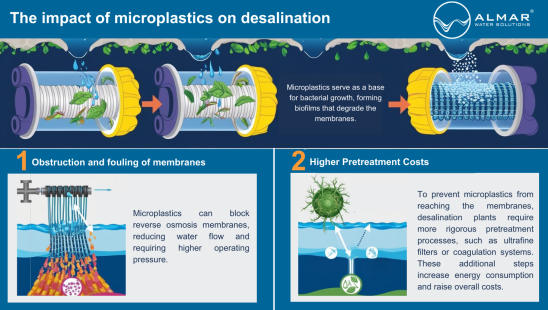
The Invisible Enemy: The Impact of Microplastics on Desalination and Water Reuse
In a world where drinking water is increasingly scarce, technologies such as desalination and water reuse have become essential priorities. However, these solutions face a new challenge: microplastics. These tiny plastic fragments, less than 5 mm in size, may seem insignificant, but they are profoundly affecting our ability to ensure clean water.
How does this invisible enemy impact these technologies?
Each year, an estimated 11 million tons of plastic end up in the oceans, breaking down slowly into microscopic particles. These microplastics are not only found in oceans, seas, and rivers but also in drinking water, wastewater, and consequently in water treatment systems.
A study by the University of Newcastle revealed that, on average, a person ingests about 5 grams of microplastics per week (equivalent to the weight of a credit card). This phenomenon not only poses health risks but also threatens the systems that process water for human consumption.
The Impact of Microplastics on Desalination
Desalination, particularly through reverse osmosis, is a crucial technology for converting saline water into drinking water. However, the presence of microplastics can make this process more costly and less efficient.

Concerns over the presence of these particles in drinking water have grown in recent years, but desalination—specifically reverse osmosis—offers a reliable solution. Reverse osmosis membranes are designed to filter extremely small particles, even at the molecular level, making them highly effective. This technology ensures that the resulting water is free of contaminants such as salts, bacteria, and, of course, microplastics. Thus, desalination not only guarantees access to potable water but also stands out as one of the most efficient technologies to address this environmental challenge.
The Impact of Microplastics on Water Reuse
Similarly, water reuse is a cornerstone of sustainability, especially in regions experiencing water stress. However, microplastics can impact both treatment processes and the quality of recycled water.

Despite their effects and the sense that this issue lacks a short-term solution, strategies are already in place to mitigate their footprint and make water reuse an efficient strategy to tackle current water shortages:
- Technologies designed to capture nanometric particles are already being implemented.
- Processes utilizing materials like activated carbon or coagulants to trap microplastics before they enter critical systems are being adopted.
- Techniques such as electrochemical oxidation have proven effective in breaking microplastics down into simpler molecules.
Nevertheless, reducing plastic pollution at its source is essential. Banning single-use plastics and improving waste management systems can significantly reduce the amount of microplastics in water.
Let’s Not Drink Our Mistakes: Plastic-Free Solutions
Faced with the growing challenge of microplastics, Almar Water Solutions is providing tools and strategies to mitigate this problem. Our projects leverage cutting-edge technologies to ensure high-quality drinking water, even in regions with severe water scarcity.
Desalination remains the most effective water treatment method for removing microplastics from drinking water. A prime example is our Shuqaiq 3 desalination plant in Saudi Arabia, which incorporates advanced technologies to guarantee sustainability and water quality, even against emerging contaminants like microplastics.
Microplastics are challenging our ability to address the global water crisis. Tackling this issue requires a multidisciplinary approach: technological innovation, stricter public policies, and above all, a collective commitment to reduce our dependence on plastics.
In a world where every drop is precious, we cannot allow plastic to dominate our water solutions. It’s time to stop drinking our mistakes.
Bibliography

